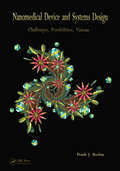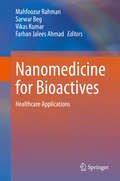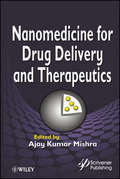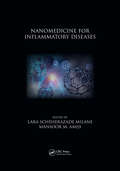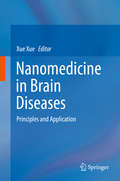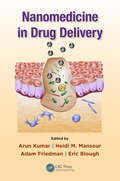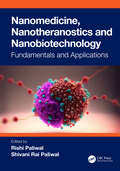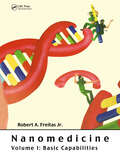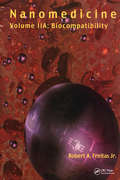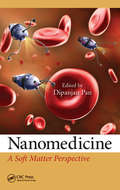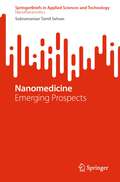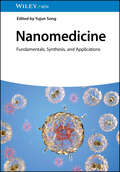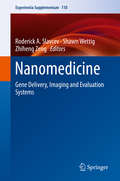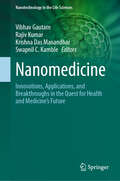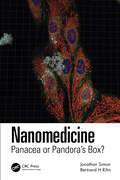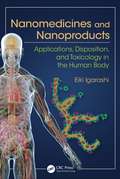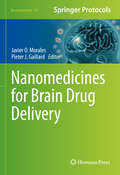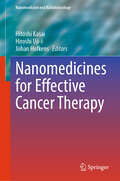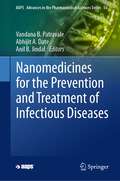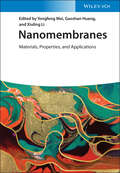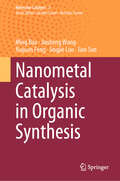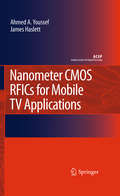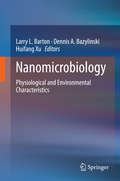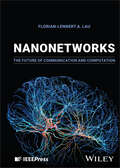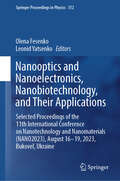- Table View
- List View
Nanomedical Device and Systems Design: Challenges, Possibilities, Visions
by Frank J. BoehmNanomedical Device and Systems Design: Challenges, Possibilities, Visions serves as a preliminary guide toward the inspiration of specific investigative pathways that may lead to meaningful discourse and significant advances in nanomedicine/nanotechnology. This volume articulates the development and implementation of beneficial advanced nanomedical diagnostic and therapeutic devices and systems, which may have strong potential toward enabling myriad paradigm shifts in the field of medicine. In addition, it presents conceptual and laboratory-derived examples of how sophisticated, highly efficient, minimally invasive, and cost-effective nanomedical diagnostic and therapeutic strategies might facilitate significantly increased accessibility to advanced medical procedures to assist those in both the developing and developed worlds. Explorations of nanomedicine in human augmentation, longevity and space travel are also undertaken.
Nanomedicine for Bioactives: Healthcare applications
by Vikas Kumar Sarwar Beg Mahfoozur Rahman Farhan Jalees AhmadNanotechnology is opening up new avenues in all scientific and technological fields. Among the novel applications, bioactives and nutraceuticals are fast-growing areas of nano research for better healthcare solutions. A variety of nanoformulations, such as polymeric nanoparticles, nanocapsules, nanoemulsions, transferosomes and ethosomes, liposomes, lipospheres, and lipid polymer hybrid nanoparticles have proved valuable in bioactive delivery and food materials. Further, new herbal drugs and nutraceuticals are reported to have remarkable advantages over conventional formulations of plant actives and extracts, including enhanced solubility, bioavailability, multiple drug delivery, greater stability, sustained delivery, improved tissue macrophage distribution, protection from toxicity, enhancement of pharmacological activity and protection from physical and chemical degradation. This book focuses on the advanced nanomaterials that are utilized for the encapsulation of nutrients/vitamin/phytoconstituents, as well as their other healthcare benefits.
Nanomedicine for Drug Delivery and Therapeutics
by Ajay Kumar MishraThis book describes a broad area of nanomedicine which involves mainly applications, diseases, and diagnostics. The comprehensive coverage provides researchers, academics, and health specialists with a great tool, that includes techniques applicable to various uses.
Nanomedicine for Inflammatory Diseases
by Lara Scheherazade Milane Mansoor M. AmijiNanomedicine for Inflammatory Diseases is a cutting-edge resource for clinicians and scientists alike, working at the intersection of development and clinical therapeutics. This text is ideal for graduate level courses in nanomedicine, translational medicine, or inflammatory disease. <P><P>This book is a progressive hallmark in translational medicine as it unites clinicians treating inflammatory disease with scientists developing experimental nanomedicine therapeutics. The commonality is made through a translational nanomedicine expert – bridging the gap between the laboratory benchtop and the clinical bedside.
Nanomedicine in Brain Diseases: Principles and Application
by Xue XueThis book provides an overview of the current applications of nanomaterials in brain diseases, and introduces several novel nanomaterials that have excellent potential in this field. During the last two decades, nanotechnology had matured significantly as it has transitioned from a bench-top science to an applied technology. However, the application of nanomaterials in basic and clinical neuroscience is still at an early stage, and understanding how the intrinsic properties of nanomaterials translate to complex biological responses is an area of intensive research. Part 1 of the book focuses on the principles and strategies of nanomedicine in the brain diseases, while part 2 examines the applications of promising nanomaterials for therapy and diagnosis in the brain. Together they offer a comprehensive picture of advances in nanotechnology and their successful use in treating brain diseases in the past 20 years.
Nanomedicine in Drug Delivery
by Adam Friedman Heidi M. Mansour Arun Kumar Eric R. BloughThere is a clear need for innovative technologies to improve the delivery of therapeutic and diagnostic agents in the body. Recent breakthroughs in nanomedicine are now making it possible to deliver drugs and therapeutic proteins to local areas of disease or tumors to maximize clinical benefit while limiting unwanted side effects. Nanomedicine in D
Nanomedicine, Nanotheranostics and Nanobiotechnology: Fundamentals and Applications
by Rishi Paliwal Shivani Rai PaliwalNanosized particles explored for therapeutics and diagnosis-related research areas need the latest updated information for budding researchers as well as academicians. Nanomedicine, nanotheranostics, and nanobiotechnology have been contemporary technological tools for diverse biomedical, pharmaceutical, and diagnostic solutions. The present book is divided into two sections.The first section is dedicated to exclusive book chapters related to nanomedicine such as its history, regulatory aspects, scale-up, and regulatory toxicology. Additionally, this section includes chapters focusing on the application domain of nanomedicine for targeted cancer therapy, rheumatoid arthritis management, psoriasis treatment, ocular delivery, topical applications, oral bioavailability enhancement, and pulmonary delivery.The second section is composed of chapters in the area of nanotheranostics and applications of nanobiotechnology. In brief, the latest topics such as gold nanoparticles in diagnostics and therapy, nanoparticles for siRNA delivery, carbon nanotubes for gene delivery, nanoparticles for vaccine delivery, nanobiotechnology in cell-based nanomedicines, nanotechnology in regenerative medicine, and nanocarriers in delivery of proteins and peptides are complied.KEY FEATURES A total of 26 emerging topics are covered in the book on cutting-edge research areas at the multi-disciplinary level. The chapters focus on fundamentals and applications, making the book attractive for beginners as well as experts. The chapters are written by well-known experts of the field in a simple scientific style with figures, schemes, and illustrations.
Nanomedicine, Volume I: Basic Capabilities
by Robert A. FreitasMolecular nanotechnology has been defined as the three-dimensional positional control of molecular structure to create materials and devices to molecular precision. The human body is comprised of molecules, hence the availability of molecular nanotechnology will permit dramatic progress in human medical services. More than just an extension of "molecular medicine," nanomedicine will employ molecular machine systems to address medical problems, and will use molecular knowledge to maintain and improve human health at the molecular scale. Nanomedicine will have extraordinary and far-reaching implications for the medical profession, for the definition of disease, for the diagnosis and treatment of medical conditions including aging, for our very personal relationships with our own bodies and ultimately for the improvement and extension of natural human biological structure and function. This book will be published in three volumes over the course of several years. Readers wishing to keep up-to-date with the latest developments may visit the nanomedicine website maintained by the Foresight Institute (http://foresight.org/Nanomedicine/index.html).
Nanomedicine, Volume IIA: Biocompatibility
by Robert A. FreitasThe safety, effectiveness, and utility of medical nanorobotic devices will critically depend upon their biocompatibility with human organs, tissues, cells, and biochemical systems. In this Volume, we broaden the definition of nanomedical biocompatibility to include all of the mechanical, physiological, immunological, cytological, and biochemical re
Nanomedicine: A Soft Matter Perspective
by Dipanjan PanThe unprecedented potential of nanotechnology for early detection, diagnosis, and personalized treatment of diseases has found application in every biomedical imaging modality. However, with the increasing concern about the ethical and toxicity issues associated with some "nanoplatforms," biomedical researchers are in pursuit of safer, more precise
Nanomedicine: Emerging Prospects (SpringerBriefs in Applied Sciences and Technology)
by Subramanian Tamil SelvanThis book highlights the emerging paradigm of nanomedicine, intersecting two burgeoning fields of nanotechnology and medicine. Numerous publications have appeared in the literature over the years, especially in cancer nanomedicine. In a boarder sense, nanomedicine aims to apply the knowledge and tools of nanotechnology in a mission to diagnose early and prevent or treat diseases using biocompatible nanoparticles (NPs). Current research in nanomedicine and its prospects depend on creating new breakthroughs at the nexus of nanomaterials and biological systems, making use of non-toxic NPs and nano/biomaterials as smart theranostic systems for a variety of diseases including cancer, neurodegenerative, orthopedic, and cardiac diseases. This book provides a review on recent advancements of nanomedicine in the aforementioned emerging areas of nanomedicine.
Nanomedicine: Fundamentals, Synthesis, and Applications
by Yujun SongA comprehensive and multidisciplinary guide to nanomaterials-based medicine Nanomedicine is the study and application of nanomaterials-based medical techniques. In recent years it has very rapidly become indispensable in a huge range of medical contexts, from analysis of extreme life events to diagnosis and treatment of life-threatening intractable diseases, such as cancers and cardiovascular diseases. It has already transformed both research and clinical outcomes in many areas of medicine and promises to continue as the cutting-edge research and clinical area for the next generation of medical specialists. Nanomedicine: Fundamentals, Synthesis, and Applications constitutes a comprehensive guide to this subfield and its recent advances. Beginning with a brief history of the field and introduction to its core principles, it thoroughly treats recent developments in this vital and ever-growing field. Its multidisciplinary approach equips the reader with a systematic overview of these life-saving developments in medicine. Nanomedicine readers will also find: Edited by a leading researcher with decades of experience in both North America and ChinaDetailed treatment of subjects including nanocarriers, nanomaterial bioprobes, multi-function nanodrugs, nanomedicine-mediated immunotherapy and/or physical ablation, and moreA comprehensive volume treats every facet of the subject Nanomedicine is a vital resource for biochemists, biomedical engineers, pharmaceutical chemists, physicists, and professionals in the biotechnological industries, as well as for clinicians looking to familiarize themselves with nanomedical techniques and instrumentation.
Nanomedicine: Gene Delivery, Imaging and Evaluation Systems (Experientia Supplementum #110)
by Roderick A. Slavcev Shawn Wettig Zhiheng ZengThis work was compiled to serve as a convenient source that covers a number of techniques (and details of their use) in the rather large field of nanomedicine, with special attention paid to gene delivery. As principal investigators working in the field of nanomedicine, we sought to put together the most current and relevant topics in gene delivery, imaging and evaluation systems. We expect the work to serve very well for scientists and graduate students in the nanomedicine field.
Nanomedicine: Innovations, Applications, and Breakthroughs in the Quest for Health and Medicine's Future (Nanotechnology in the Life Sciences)
by Rajiv Kumar Vibhav Gautam Krishna Das Manandhar Swapnil C. KambleNanotechnology is revolutionizing healthcare, by providing innovative solutions to some of the most challenging issues in medicine. This book provides an in-depth overview of nanoscale materials and devices that are advancing diagnostics, therapeutics, and personalized care in medical field. It focuses on nanomedicine’s impact on vaccine efficacy as well as innovative diagnosis and therapy for various type of cancer while addressing concerns about safety and toxicity. It examines how nanotechnology is enhancing drug delivery by precisely targeting medicines to specific cells or tissues, thereby increasing treatment efficacy with reduced side effects. This book also explores how nanoparticles are advancing medical imaging for earlier and more accurate disease detection, and how nanosensors allow real-time biomarker monitoring for faster and more reliable diagnoses. Additionally, it explores nanomedicine's role in managing cardiovascular diseases, improving bone health through nano-extracellular vesicles, and regenerative medicine, including ongoing clinical trials and ethical considerations. This book is an essential resource for researchers, practitioners, and students, offering a comprehensive exploration of nanomedicine’s role in shaping the future of health and medicine leading to a new era of precision medicine and improved patient care.
Nanomedicine: Panacea or Pandora's Box?
by Jonathan Simon Bertrand H. RihnThe book is an introduction to nanomedicine informed by a philosophical reflection about the domain and recent developments. It is an overview of the field, sketching out the main areas of current investment and research. The authors present some case-studies illustrating the different areas of research (nanopharmacy, theranostics and patient monitoring) as well as reflecting on the risks that accompany it, such as unanticipated impacts on human health and environmental toxicity. This introduction to a fast-growing field in modern medical research is of great interest to researchers working in many disciplines as well as the general public. In addition to an overview of the work currently ongoing, the authors critically assess these projects from an ethical and philosophical perspective. Key Features Provides an overview of nanomedicine Employs a reflective and coherent critical evaluation of the benefits and risks of nanomedicine Written in an accessible manner intended for a wide audience Related Titles Hehenberger, M. Nanomedicine: Science, Business, and impact (ISBN 978-9-8146-1376-7). Beg, S., et al. Nanomedicine for the treatment of Disease: From Concept to Application (ISBN 978-1-7746-3443-1) Brenner, S. The Clinical Nanomedicine Handbook (ISBN 978-1-1380-7578-8)
Nanomedicines and Nanoproducts: Applications, Disposition, and Toxicology in the Human Body
by Eiki IgarashiNanomedicines and Nanoproducts: Applications, Disposition, and Toxicology in the Human Body provides a detailed overview of the disposition of nanoproducts within the body, with a special focus on the respiratory and olfactory routes of nanoproduct administration, buccal exposure and the ingestion of nanoproducts, the integumentary system (formed by the skin, hair, nails, and associated glands), the ocular route, the systemic route, and toxicology as it relates to the nanoscale world.Offering an interdisciplinary, big-picture view of the current and future state of nanotechnology, this book: Identifies key points for the entry of nanoproducts, nanomedicines, and other nanoscale structures into the body Reviews the bodily administration and subsequent disposition of nanoproducts via various exposure routes Describes the intravenous route of administration for the therapeutic management of ocular disease Discusses practical nanoproduct and nanomedicine applications, disposition, and toxicology Summarizes various toxicological principles and the testing of nanoproducts Nanomedicines and Nanoproducts: Applications, Disposition, and Toxicology in the Human Body addresses the scope of practical nanoparticle applications in academic research as well as industrial investigation, where "practical" is defined as advantageous in all aspects of nanoproduct disposition, efficacy, and toxicology. The book’s goal is to introduce potentially beneficial applications and exciting topics regarding nanoproducts to a variety of professional and general readers.
Nanomedicines for Brain Drug Delivery (Neuromethods #157)
by Javier O. Morales Pieter J. GaillardThis volume explores the latest research in central nervous system (CNS) targeted nanocarriers, methods for their synthesis, and its characterization process. Chapters in this book cover topics such as polymeric nanoparticles and liposomes; self-assembled peptide-based scaffolds for lesions of the nervous system; use of peptides as CNS drugs and as potential carriers to optimize brain-targeted delivery; ways to model and assess blood brain barrier absorption of drugs; and the role of neurodegeneration progress of nanomaterials and their potential toxicity concerns. In the Neuromethods series style, chapters include the kind of detail and key advice from the specialists needed to get successful results in your laboratory.Thorough and cutting-edge, Nanomedicines for Brain Drug Delivery is a valuable resource that will help researchers guide and advance the field of nanomedicines for the brain and nervous system.
Nanomedicines for Effective Cancer Therapy (Nanomedicine and Nanotoxicology)
by Johan Hofkens Hitoshi Kasai Hiroshi Uji-IThis book describes in detail the most up-to-date designs and fabrication techniques for nanomedicines toward effective cancer therapy, while especially emphasizing the biological interaction of nanomedicines at the cellular level, through comprehensive and visual cutting-edge technologies. Unlike other books on the general subject of medicine or drug delivery, this book provides readers the comprehensive information regarding what happens to the nanomedicine at the cell membrane surface, uptake mechanism, and what biochemical process it undergoes inside the cellular matrix. This full overview of the interaction between nanomedicines and cells also provides insights of how to design nanomedicines for effective cancer therapy.
Nanomedicines for the Prevention and Treatment of Infectious Diseases (AAPS Advances in the Pharmaceutical Sciences Series #56)
by Vandana B. Patravale Anil B. Jindal Abhijit A. DateThe COVID-19 pandemic has altered the world and reiterated the perpetual need for the development of effective strategies for the prevention and treatment of infectious diseases. While globally prevalent infectious diseases receive extensive attention in terms of drug development and delivery, the neglected and/or emerging infectious diseases that affect developing countries are often overlooked. Additionally, the therapeutic efficacy of existing anti-infective agents is often limited due to sub-optimal biopharmaceutical properties, sub-therapeutic levels of the drugs at the infection site due to various physiological barriers, the expulsion of the drug by efflux transporters, and the emergence of drug-resistant strains.From the commercialization of AmBisome® to the emergency authorization of mRNA-based vaccines, nanotechnology has played a vital role in the prevention and treatment of infectious diseases. More importantly, nanotechnology has enabled the effective utilization of existing armamentarium against infectious diseases leading to improved therapeutic outcomes with a concomitant reduction in the side effects associated with anti-infective agents. In particular, nanotechnology can bring about a paradigm shift in the management of neglected and emerging infectious diseases and may compensate for the lack of drug discovery efforts. While there are several books dedicated to pharmaceutical and/or biomedical applications of nanotechnology or nanotechnology for cancer therapy a comprehensive book focusing on the prevention and/or treatment of viral, bacterial, fungal, and parasitic infections is not available. This book addresses an unmet need in pharmaceutical and medical education.This book provides a comprehensive and up-to-date overview of the latest advancements in nanomedicine, which show great potential for preventing and treating infectious diseases. Covering a wide range of topics, it explores various formulation strategies for combating microbial, fungal, parasitic, and viral infections. The book emphasizes the advantages of nano-scale vaccines over traditional ones and discusses their production. It also examines feasible treatment approaches for diseases like malaria, trypanosomiasis, candidiasis, Hepatitis B, HIV, and the ongoing COVID-19 pandemic. Additionally, it highlights the role of nano-adjuvants in vaccine development, as well as the use of peptide antibiotics and pulmonary delivery of drugs, which open up new possibilities in fighting infectious diseases. Furthermore, the book explores the critical role of nanomedicine in addressing veterinary parasitic infections. The emergence of nanotechnology has led to novel strategies for diagnosing, treating, and preventing parasitic infections in animals.In summary, this book offers a comprehensive description of clinically viable and investigational nanotechnology-enabled medicines (nanomedicines) for the prevention and treatment of globally prevalent, neglected, and emerging infectious diseases.
Nanomembranes: Materials, Properties, and Applications
by Yongfeng Mei Gaoshan Huang Xiuling LiNanomembranes Provides a thorough overview of the field of nanomembranes, covering materials science, fabrication processes, properties, and applications In recent years, the unique nature of the nanomembrane has led to new technology and applications in areas including flexible electronics, photonics, robotics, biology, microelectromechanical systems, and lab-on-a-chip (LOC) devices. Highly suitable for assembling three-dimensional structures, the nanomembrane can be integrated into devices and systems using conventional thin film technology. Nanomembranes: Materials, Properties, and Applications is an up-to-date review of recent advances in the rapidly expanding area within nanoscience and technology. Edited by leading researchers, the book covers the fabrications, properties, applications, design concepts, and challenges of nanomembranes and other nano-scale assembled structures. In-depth chapters address topics including three- and four-dimensional origami, nanomembrane-based transient electronics, development of inorganic flexible electronics, magnetic nanomembranes, bio-applications of three-dimensional scaffolds, nanomembrane-based micro and nanorobots, passive electronic components based on self-rolled-up nanomembranes, and more. Covers nanomembranes as well as nanostructures made from semiconductor, metal, insulator, polymer, and composite materials Provides broad overview of two-dimensional materials and assembled structures including origami and kirigami structures Explores applications of nanomembrane such as batteries, supercapacitors, robotics, electronics, and cell scaffolding Discusses nanomembranes made from polymeric materials, mechanical forces during deformation, and assembly of nanomembranes, Addresses monolayer two-dimensional materials such as graphene and transition metal dichalcogenides Nanomembranes: Materials, Properties, and Applications is an invaluable resource for material scientists, engineers, physicists, and chemists in academia and industry, and an excellent text for graduate students and researchers across disciplines with interest in the rapidly growing field.
Nanometal Catalysis in Organic Synthesis (Molecular Catalysis #3)
by Jian Sun Xiujuan Feng Ming Bao Jiasheng Wang Jingjie LuoThe book explains principles and fundamentals of nano-metal catalysis in organic synthesis and highlights the current developments and future potential of the green chemistry-oriented applications of metal nanocatalysts. It consists of six chapters, including introduction; organic synthesis catalyzed by metal nanoparticles; organic synthesis catalyzed by metal nanoclusters; organic synthesis catalyzed by metal single atoms; organic synthesis catalyzed by nanoporous metals; and conclusions and outlook. It introduces the latest advances in preparation, characterization, and catalytic application of metal nanocatalysts, elucidates the catalytic mechanisms of various metal nanocatalysts, and inspires rational catalyst design. This book is interesting and useful to a wide readership in various fields of chemical science and engineering.
Nanometer CMOS RFICs for Mobile TV Applications
by Ahmed A. Youssef James HaslettNanometer CMOS RFICs for Mobile TV Applications focuses on how to break the trade-off between power consumption and performance (linearity and noise figure) by optimizing the mobile TV front-end dynamic range in three hierarchical levels: the intrinsic MOSFET level, the circuit level, and the architectural level. It begins by discussing the fundamental concepts of MOSFET dynamic range, including nonlinearity and noise. It then moves to the circuit level introducing the challenges associated with designing wide-dynamic range, variable-gain, broadband low-noise amplifiers (LNAs). The book gives a detailed analysis of a new noise-canceling technique that helps CMOS LNAs achieve a sub - 2 dB wideband noise figure. Lastly, the book deals with the front-end dynamic range optimization process from the systems perspective by introducing the active and passive automatic gain control (AGC) mechanism.
Nanomicrobiology
by Larry L. Barton Dennis A. Bazylinski Huifang XuThis book is devoted to nanomicrobiology and the nanosystems of bacteria. The initial chapter discusses some of the controversies in the geochemical and biomedical fields associated with the reports of nanobacteria in the environment. Current knowledge of several internal and surface structures of bacteria is addressed in this book. Included are chapters discussing carboxysomes, S-layers, gliding motility of bacteria, and aggregation of iron to produce nano-magnetite. Information about the activities of outer membrane vesicles produced by Gram-negative bacteria is discussed as a benefit to bacteria that produce it and some potential industrial applications are presented. A broad review of bacterial-mineral interactions is addressed in a chapter of metallic nanoparticles and colloids production by bacterial reduction of soluble redox active elements. The structures of bacterial nanowires are discussed and their application in extra-cellular electron transport is reviewed. Nanomotor activities of bacteria are discussed as pertains to the mechanics of flagellar rotation, production of energy by ATP synthase, DNA packing, and translocation of proteins across membranes by secretion systems. The rapidly evolving field of nanosystem technology is embracing many areas, and it is the hope that this book will stimulate the use of bacterial nanostructures for future developments in nanotechnology.
Nanonetworks: The Future of Communication and Computation
by Florian-Lennert A. LauLearn the basics—and more—of nanoscale computation and communication in this emerging and interdisciplinary field The field of nanoscale computation and communications systems is a thriving and interdisciplinary research area which has made enormous strides in recent years. A working knowledge of nanonetworks, their conceptual foundations, and their applications is an essential tool for the next generation of scientists and network engineers. Nanonetworks: The Future of Communication and Computation offers a thorough, accessible overview of this subject rooted in extensive research and teaching experience. Offering a concise and intelligible introduction to the key paradigms of nanoscale computation and communications, it promises to become a cornerstone of education in these fast-growing areas. Readers will also find: Detailed treatment of topics including network paradigms, machine learning, safety and securityCoverage of the history, applications, and important theories of nanonetworks researchExamples and use-cases for all formulas and equations Nanonetworks is ideal for advanced undergraduate and graduate students in engineering and science, as well as practicing professionals looking for an introductory book to help them understand the foundations of nanonetwork systems.
Nanooptics and Nanoelectronics, Nanobiotechnology, and Their Applications: Selected Proceedings of the 11th International Conference on Nanotechnology and Nanomaterials (NANO2023), August 16-19, 2023, Bukovel, Ukraine (Springer Proceedings in Physics #312)
by Leonid Yatsenko Olena FesenkoThis book highlights some of the latest advances in nanotechnology and nanomaterials from leading researchers in Ukraine, Europe, and beyond. It features contributions from participants of the 11th International Conference Nanotechnology and Nanomaterials (NANO-2023) in Bukovel, Ukraine on August 16-19, 2023 organized by the Institute of Physics of the National Academy of Sciences of Ukraine, University of Tartu (Estonia), University of Turin (Italy), and Pierre and Marie Curie University (France). Worldwide experts present scientific achievements in key topics such as nanophysics, nanophotonics, nanooptics, nanoplasmonics, nanoelectronics, and nanobiotechnology. The book explores a significant branch of nanoscience and introduces new opportunities for synergistic research. Specifically, it: • presents new methods for the synthesis and characterization of nanomaterials, nanocomposites and various nanostructures • presents microscopy, spectroscopy and laser imaging techniques for nanomaterials and nanocomposites • presents novel advances in nanophysics, nanooptics, nanophotonics, and nanoplasmonics • covers nanobiotechnology and nanochemistry, and their applications. This Book is essential reading for advanced undergraduate and graduate students, senior scientists, and industry representatives. It includes up-to-date results of investigations in nanotechnology and nanomaterials, along with promising its applications from nanophysics to nanomedicine.
